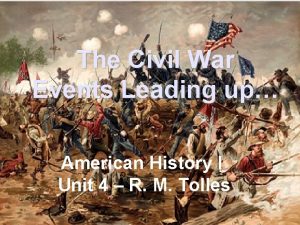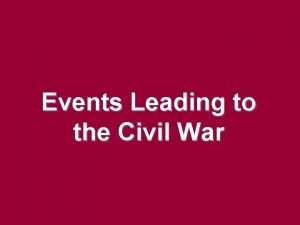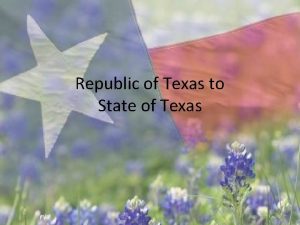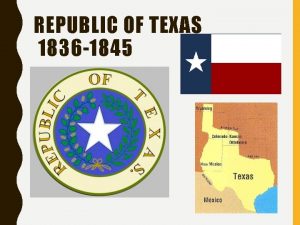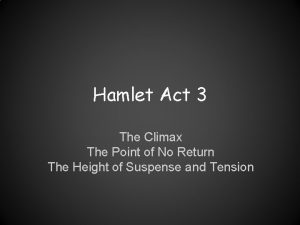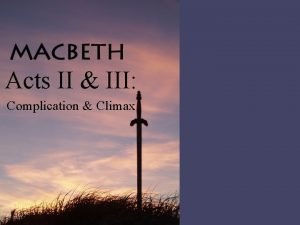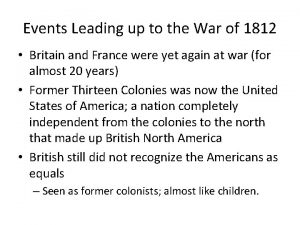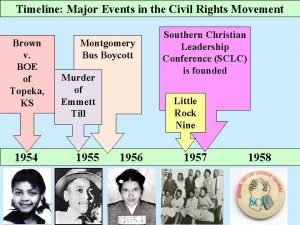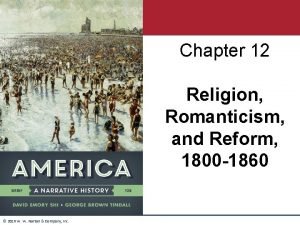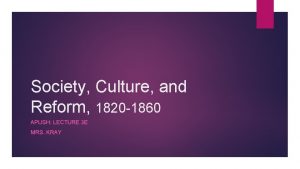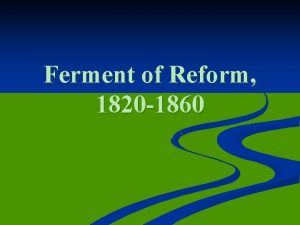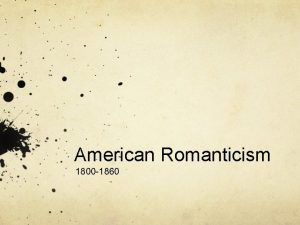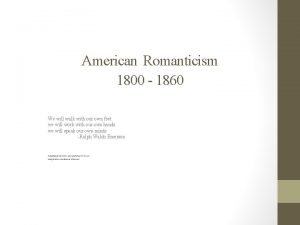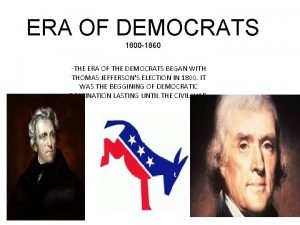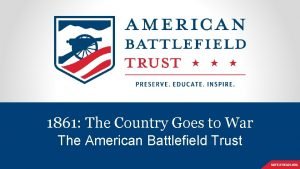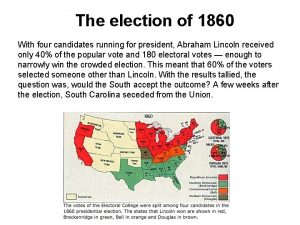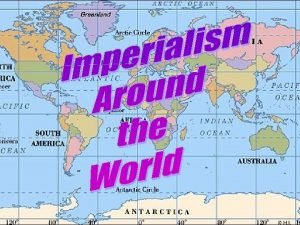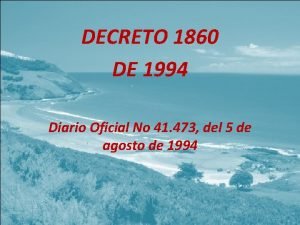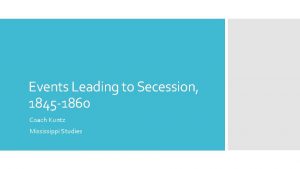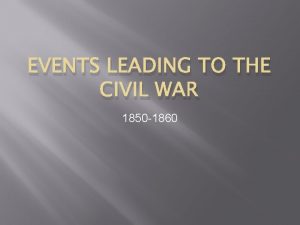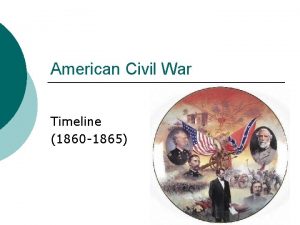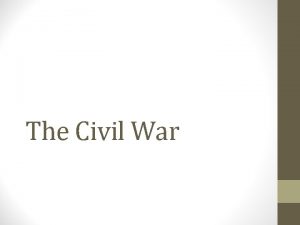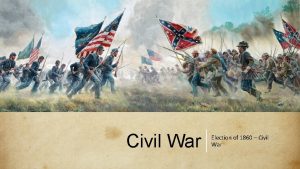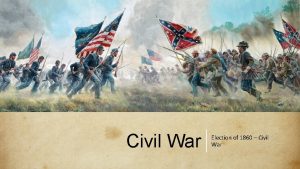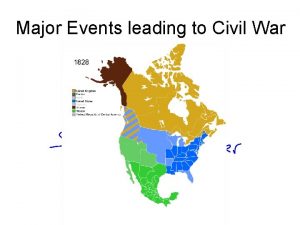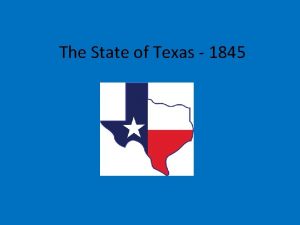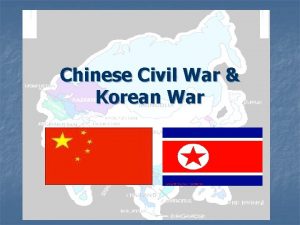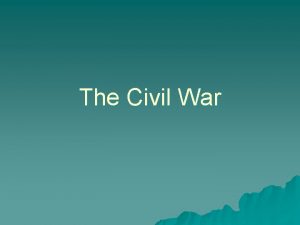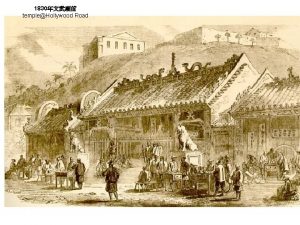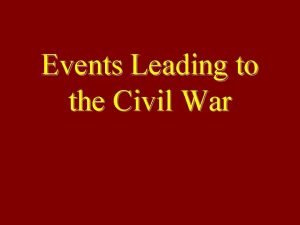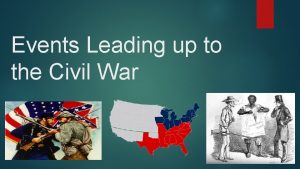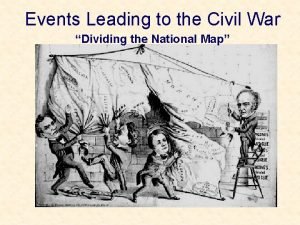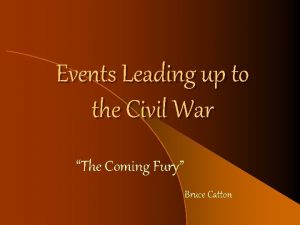EVENTS LEADING TO THE CIVIL WAR 1845 1860



























- Slides: 27

EVENTS LEADING TO THE CIVIL WAR 1845 -1860

Sectionalism and States Rights

Sectionalism North • Factories • Fishing • Whaling • Railroads • Large Population • Cities West South • Pioneer • Farms • Hunting • Mining • Lumber • Ranching • Indian Issues • Farming • Cash Crops • Slave Labor • Ranching • Cotton • Class Differences

Popular Sovereignty in the West � Let the people decide if they want slavery or not in the western territories � Started by Senator Stephen Douglas of Illinois

Compromise of 1850 � � Admits California as a free state Abolishes slave trade in Washington, D. C. Popular sovereignty in western territories Fugitive slave law***

Abolitionists � � � Quakers William Lloyd Garrison Frederick Douglass Henry David Thoreau Sarah and Angelina Grimke

Uncle Tom’s Cabin � � � Novel by Harriet Beecher Stowe Focuses on slave life in Kentucky and Louisiana Uncle Tom is a good and complacent soul Simon Legree is the evil slave driver Eliza flees to freedom by crossing the icy Ohio River Lincoln called Stowe the “little lady who started the Civil War”

Published in 1852

Underground Railroad and Fugitive Slave Law � � Fugitive slave law—federal violation for aiding runaway slaves Secret escape routes to Northern free states Harriet Tubman— “Moses” Quakers

Twelve Years a Slave � � � Published in 1863 Memoir of Solomon Northrup of NY Captured in 1841 and rescued on 1853 Movie in 2013—filmed in Louisiana Earned Oscar for Best Picture of 2014

Kansas-Nebraska Act-1854 � � � Popular sovereignty in Kansas and Nebraska territories (let the people decide through voting for or against slavery) Led to “Bleeding Kansas” Abolitionists led by John Brown

Kansas-Nebraska Act

Dred Scott v. Sanford

The Dred Scott Case � � � Supreme Court Decision in 1857 Dred Scott sued his master for freedom after Sanford had taken him to a free state Chief Justice Taney wrote the ruling that slaves were property, not citizens and could not sue Slaves could be taken into any state and are still slaves Only a constitutional amendment could overrule this momentous decision Southerners rejoiced and Northerners were outraged

Abolitionist Activity

Brooks-Sumner Incident � � � Massachusetts Senator Charles Sumner gave abolitionist speech in 1856 He insulted slave owner Andrew Butler, uncle of Preston Brooks—both from South Carolina Three days later, Congressman Brooks decided that Sumner was beneath dueling since he was no gentleman He beat Sumner with a cane, seriously injuring him Brooks was censured and Sumner became a strong advocate of Radical Reconstruction

The attack on Sumner was applauded across the South

John Brown and Harpers Ferry-1859 � � � John Brown led a “holy war” of escaped slaves against the white race He captured the arsenal at Harpers Ferry, Virginia (today, West Virginia) Colonel Robert E. Lee was sent to capture the rebels Many rebels were killed including some of Brown’s sons Brown was captured, tried and hanged Songs and pictures showed Brown as a hero to the abolitionist cause

John Brown—Hero or Criminal?

Other Terms: � � Gag rule— 1835 -1844—no anti-slavery discussion in Congress allowed—J. Q. Adams said this violated 1 st amendment Free Soil Movement— 3 rd party 1848 -54— against slavery in western territories Wilmot Proviso— 1845—proposal to ban slavery in lands won from Mexico—FAILED Nullification Crisis—Jackson vs. SC over protective tariff—do states have a right to nullify federal law?

Presidents � Zachary Taylor—Whig � Millard Fillmore—Whig Franklin Pierce --Democrat � James Buchanan --Democrat �

The Republican Party � � � Formed in 1854 in Wisconsin Principle: against the spread of slavery into the western territories John C. Fremont (Western trailblazer) ran as a Republican for President in 1856 (lost) Abraham Lincoln, a Whig, joined the party and became the first Republican President The party dominated 19 th and early 20 th century presidencies

The Lincoln-Douglas Debates � � � Seven debates for the two candidates for U. S. Senate from Illinois— 1858 Democrat Stephen Douglas (“the little giant”) vs. Republican Abraham Lincoln (“the rail splitter”) “A house divided against itself cannot stand. ” (Abraham Lincoln) Douglas promoted popular sovereignty Douglas won the election to Senate

Lincoln vs. Douglas

Election of 1860 Douglas—Democrat— 12 electoral votes— 29. 4% popular vote � Breckenridge—National Democrat (Southern) — 72 electoral votes— 18% popular vote � Bell—Constitutional Union— 39 electoral votes — 12% popular vote � Lincoln—Republican--180 electoral votes--39. 8% popular vote *After the election, S. C. seceded* �

Create a Circle Graph “Slavery: Statistics vs. Myths” � � � � ¾ % owned over 50 slaves 2. 5% owned 20 -49 slaves 4% owned 10 -19 slaves 5. 75 % owned 5 -9 slaves 7% owned 2 -4 slaves 5% owned 1 slave 75% owned no slaves Why, then, did the South fight so hard to keep this institution?

Quick Check � 1. Make a chart entitled Events Leading to The Civil War � 2. Include three categories: political, social and economic � 3. List 12 events under the three categories with at least 3 in each
 Kansas nebraska act
Kansas nebraska act What events led to the civil war
What events led to the civil war Deltapine 1845
Deltapine 1845 Texas territory
Texas territory Republic of texas map 1845
Republic of texas map 1845 Chapter 16 lesson 2 challenges to slavery
Chapter 16 lesson 2 challenges to slavery Civil war first modern war
Civil war first modern war Objectives of roving frame
Objectives of roving frame What is the climax of hamlet act 3
What is the climax of hamlet act 3 Hamlet act 3 events leading to climax
Hamlet act 3 events leading to climax Leading up to the war of 1812
Leading up to the war of 1812 Civil rights webquest
Civil rights webquest Civil rights timeline of events
Civil rights timeline of events Mutually exclusive vs non mutually exclusive
Mutually exclusive vs non mutually exclusive Chapter 12 religion romanticism and reform
Chapter 12 religion romanticism and reform American romanticism 1800 to 1860 worksheet answers
American romanticism 1800 to 1860 worksheet answers Arthur and lewis tappan apush
Arthur and lewis tappan apush American reform movements between 1820 and 1860
American reform movements between 1820 and 1860 American romanticism 1800 to 1860 worksheet answers
American romanticism 1800 to 1860 worksheet answers Balai a tapis 1860
Balai a tapis 1860 Border states in 1860
Border states in 1860 Values feeling and intuition over reason
Values feeling and intuition over reason What era was the 1800
What era was the 1800 South carolina 1860
South carolina 1860 The romantic period in american literature
The romantic period in american literature Map of 1860
Map of 1860 South africa 1860
South africa 1860 Decreto 1860 de 1994
Decreto 1860 de 1994
